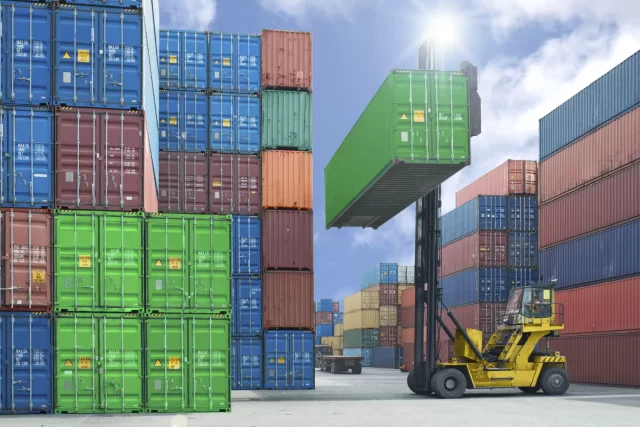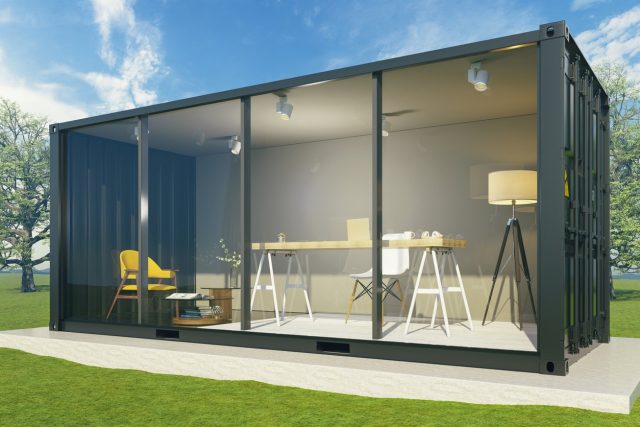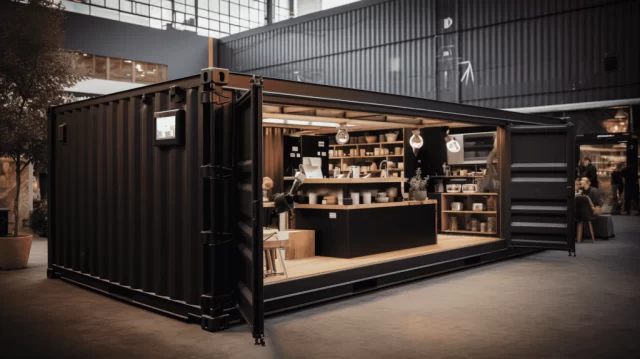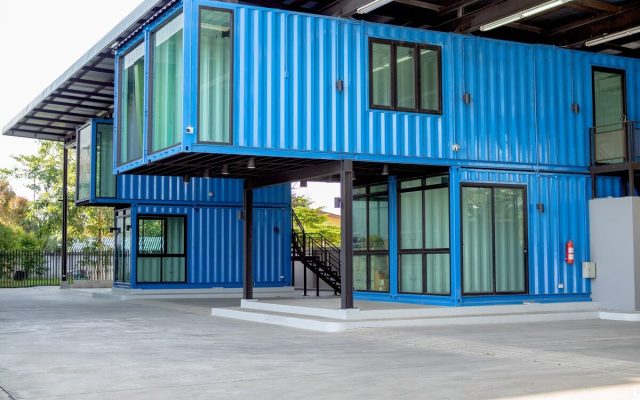The Versatile World of Shipping Containers: From Creation to Utilisation

Shipping containers, often seen as the building blocks of global commerce, are far more than just steel boxes traversing the oceans. These containers, typically made from robust, weather-resistant steel, have revolutionised the way goods are transported across the world. From electronics to apparel, they serve as a secure and efficient means to move a vast array of products, playing a pivotal role in the global supply chain.
Initially designed for the sole purpose of transporting goods over long distances, shipping containers have transcended their original role. Their impact extends beyond the realms of international trade. In recent years, these containers have found a new lease of life in various sectors, driven by their durability, modularity, and affordability.
Across the UK and beyond, innovators and entrepreneurs are repurposing shipping containers for a myriad of uses. From chic pop-up shops in London’s bustling streets to sustainable, compact housing projects in the countryside, these containers are being transformed in ways that were unimaginable when they were first introduced. This trend not only speaks to the versatility of shipping containers but also reflects a growing consciousness around sustainability and recycling.
The modern shipping container, which revolutionized global trade, was invented by Malcolm McLean, an American entrepreneur. McLean, born in 1913 in Maxton, North Carolina, was not initially in the shipping industry. He started his career with a trucking company in the 1930s.
McLean’s key insight was that efficiency in transport could be massively improved if a standard container could be loaded directly onto ships, trucks, and trains without having to unload and reload its contents each time. This concept led to the development of the first modern intermodal container.
In 1956, McLean converted an old tanker ship, the Ideal X, to carry his newly designed containers on a voyage from Newark to Houston. This maiden voyage marked the beginning of the container revolution in the shipping industry. The standardized container significantly reduced the cost of loading and unloading goods, dramatically transforming global trade by simplifying the transfer of goods across different modes of transport and making it more efficient and economical.
Manufacturing of Shipping Containers
Materials and Design
Shipping containers begin their life as rolls of high-quality, corrosion-resistant steel. The steel is cut, shaped, and welded to form the rectangular structure we are familiar with. The floors are typically made from sturdy marine-grade plywood, known for its durability and ability to withstand heavy loads. To ensure the containers are weatherproof, they are painted with special, durable coatings that can endure harsh marine environments.
Manufacturing Process
The manufacturing process involves several key steps. It begins with the steel being cut and stamped into panels, including the sides, ends, and roof. These panels are then corrugated, a process that adds strength to the thin sheets of steel. The panels are assembled and welded together, with the doors and floor being added last. The container’s structure is reinforced with square steel tubing at the corners and edges, which also facilitates stacking and handling.
Quality Control and Standards
Quality control is paramount in container manufacturing, with adherence to the International Organization for Standardization (ISO) regulations. These standards dictate dimensions, strength, and durability requirements, ensuring containers can safely be stacked, lifted, and transported. Containers undergo rigorous testing, including for weather resistance and load-bearing capacity, before they leave the factory.

Life-Cycle of a Shipping Container
Operational Life
The life of a shipping container in active transport can span 10 to 15 years, depending on the level of maintenance. During this phase, they endure harsh conditions at sea, including extreme weather and constant loading and unloading from ships to trucks and trains.
Maintenance and Repair
Regular maintenance is crucial to prolong the life of a container. This includes repairing minor damages, treating rust and corrosion, and ensuring the doors and seals are functioning correctly. Containers that are well-maintained can remain in shipping circulation for longer periods.
End of Shipping Life and Repurposing
When containers reach the end of their shipping life, they don’t necessarily head to the scrapyard. Many are repurposed for storage, converted into building structures, or used in creative projects. This second life can extend a container’s use by several decades, reducing waste and contributing to sustainable practices.
Repurposing shipping containers has gained popularity in the UK, where they serve as affordable solutions for housing, offices, and retail spaces, exemplifying a successful transition from industrial use to innovative, everyday applications.

Sizes and Specifications
Standard Sizes
Shipping containers typically come in two main sizes:
- 20-foot Containers: These are the most common, offering about 33 cubic meters of space. They are ideal for most cargo types and are widely used due to their convenient size.
- 40-foot Containers: These provide approximately 67 cubic meters of space, making them suitable for larger shipments. They are often used for bulky items or significant quantities of goods.
Specialized Types
Apart from standard containers, there are specialized variants to cater to different needs:
- High Cube Containers: Similar to standard containers but with additional height, useful for taller items.
- Refrigerated Containers: Equipped with cooling systems, these are used for perishable goods.
- Open-Top and Flat Rack Containers: Designed for cargo that doesn’t fit within the standard dimensions or requires loading from the top or sides.
Capacity and Limitations
Each container type has its own weight limit and volume capacity. It’s crucial to understand these limitations to ensure safe and efficient transportation of goods. Overloading can lead to structural damage and safety risks.
Costs in the UK
Purchase and Rental Prices
- Purchasing New Containers: Prices can vary significantly based on size and type. On average, a new 20-foot container might cost between £2,000 and £3,000, while a 40-foot container could range from £3,500 to £5,000.
- Buying Used Containers: A more affordable option, with prices depending on condition and age. A used 20-foot container might be around £1,500, and a 40-foot container could be about £2,500.
- Rental Costs: Renting a container for short-term use is a cost-effective solution. Monthly rental fees can range from £100 to £200 for standard sizes.
Factors Influencing Cost
Several factors affect the cost of shipping containers:
- Condition: New vs. used.
- Size and Type: Larger and specialized containers are more expensive.
- Delivery Fees: Transportation costs to the desired location.
- Supply and Demand: Prices can fluctuate based on market demand and availability.
Comparative analysis with international costs might reveal that UK prices are generally in line with global trends, with slight variations due to local demand and supply chain factors.
Diverse Uses of Shipping Containers
Traditional Uses
Traditionally, shipping containers are used for transporting a wide range of goods across the globe. Their standardised sizes and durability make them perfect for secure sea, road, and rail transport.
Innovative Adaptations
In recent years, the repurposing of shipping containers has gained immense popularity for various innovative uses:
- Housing: Affordable, eco-friendly, and quick to construct, container homes are a growing trend in the UK, offering a unique solution to housing shortages.
- Offices and Workspaces: Containers are being transformed into functional and stylish office spaces, particularly appealing for startups and small businesses.
- Retail and Hospitality: From trendy coffee shops to pop-up retail stores, containers offer a unique, mobile solution for businesses.
- Community Projects and Art Installations: Containers are used in community projects, like urban gardens and libraries, and as canvases for public art.
10 awesome uses
- Swimming Pools: Shipping containers have been transformed into backyard swimming pools, offering a unique, modular, and cost-effective alternative to traditional pools.
- Underground Bunkers: For those interested in survivalist culture, shipping containers are being used as bases for underground bunkers, providing a sturdy and secure structure that can be buried and fitted out for long-term living.
- Portable Saunas: Some people have converted shipping containers into portable saunas, complete with wood-fired stoves and relaxation areas, offering a unique spa experience.
- Movie Theaters: Small, intimate movie theaters have been created inside shipping containers, providing a unique cinematic experience with limited seating and a cozy atmosphere.
- Vertical Farms: In urban areas, shipping containers are being stacked and used as vertical farms, utilizing hydroponic systems to grow crops in a controlled, space-efficient environment.
- Disaster Relief Housing: In areas hit by natural disasters, shipping containers have been rapidly converted into temporary housing units, offering displaced people a quick, safe, and durable place to stay.
- Art Galleries: Artists and curators use shipping containers as mobile art galleries, bringing exhibitions to various locations and providing an industrial backdrop to the displayed artwork.
- Astronomical Observatories: Some enthusiasts have transformed containers into small, movable astronomical observatories, equipped with telescopes and observation equipment for stargazing.
- Escape Rooms: The confined space of a shipping container is ideal for creating immersive escape room experiences, where participants solve puzzles to “escape” the container.
- Recording Studios: Due to their soundproof qualities when properly insulated, shipping containers are being used as affordable, portable recording studios for musicians and podcasters.
UK-Specific Projects
In the UK, projects like container markets in London and community centres in Manchester showcase the versatility and community impact of these structures. These projects not only serve practical purposes but also stimulate local economies and foster community engagement.
Environmental Impact and Sustainability
Eco-Friendly Nature
The repurposing of shipping containers is a form of upcycling, which contributes to sustainability by reducing the need for new materials and minimising waste. By giving these containers a second life, their environmental footprint is significantly reduced.
Challenges and Solutions
While repurposing containers is sustainable, there are challenges to be addressed:
- Insulation and Energy Efficiency: Making containers habitable often requires additional insulation and energy-efficient modifications.
- Site Preparation and Infrastructure: Unlike traditional buildings, container structures may require specialised site preparation and infrastructure.
Future Trends
The future of container usage is likely to see more technological integration, like smart home features in container housing, and increased focus on sustainability, with innovations in eco-friendly modifications and materials.
In conclusion, shipping containers, once the backbone of global trade, have morphed into a symbol of innovation and sustainability. Their journey from simple transport vessels to multifaceted, eco-friendly structures is a testament to human ingenuity and a commitment to sustainable practices. This versatility not only presents a wide array of practical applications but also opens doors to creative and environmentally conscious solutions in various sectors.



